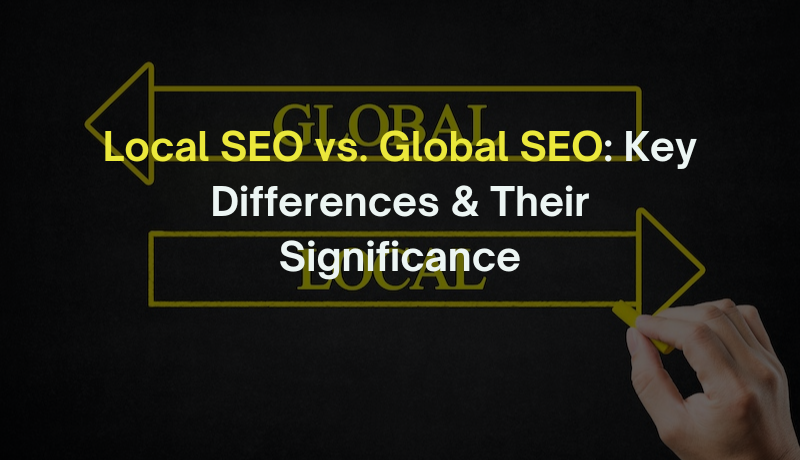Local SEO vs. Global SEO: What's the Difference and Why Does It Matter?
In today’s digital era, search engine optimization (SEO) plays a crucial role in driving organic traffic to websites. By implementing effective SEO strategies, businesses can increase their online visibility and attract relevant audiences. Two key approaches to SEO are local SEO and global SEO, each with its own distinct focus and objectives. Understanding the difference between local SEO vs global SEO is essential for digital marketers, online business owners, SEO students, and anyone aiming to optimize their website for local and global (International) audiences.
In this article, we will delve into the intricacies of local SEO vs global SEO, explore the significance of comprehending their disparities, and provide actionable strategies for improving local search rankings and expanding business reach.
Local SEO Explained
Local SEO refers to the process of optimizing a website to attract geographically targeted audiences. It aims to improve the visibility of a business within specific localities, making it more discoverable in location-based searches. Local SEO is particularly important for brick-and-mortar establishments or service-based businesses operating in specific regions.

Key Components of Local SEO and How to work for Improving Local Search Rankings?
1. Optimizing Website for Local Keywords:
Conducting local keyword research and incorporating relevant keywords into website content, meta tags, and headers to align with local search intent.
2. Google My Business Optimization and Profile Creation:
Claiming and optimizing a Google Business Profile (GBP) with accurate business information, contact details, and compelling descriptions. This helps businesses appear in Google’s local search results and Google Maps.
3. Obtaining and Managing Online Reviews:
Encouraging customers to leave reviews on platforms like Google, Yelp, or industry-specific directories. Responding to reviews, both positive and negative, demonstrates engagement and enhances the business’s online reputation.
4. Local Directory Listings and Citations:
Submitting business information, such as name, address, and phone number (NAP), to reputable local directories and citation websites. Consistency across all listings is crucial for search engines to validate the business’s credibility.
5. On-Page Optimization for Local Relevance:
Including location-specific information within website content, such as service areas or locally relevant details, to enhance local search visibility.
6. Local Link Building Strategies:
Building relationships with local organizations, associations, or influencers to acquire backlinks from reputable sources within the target locality.
In conclusion, improving local search rankings is a crucial aspect of successful local SEO. By implementing effective strategies, you can enhance your online visibility and attract more local customers. Google Business Profile optimization (GBP) listing, conducting thorough keyword research, and incorporating local keywords into your website’s content are essential steps. Building citations on reputable directories, encouraging customer reviews, and focusing on local link building also contribute to improving local search rankings.
Additionally, utilizing local schema markup provides search engines with valuable information about your business. By consistently working on these strategies, you can strengthen your local SEO efforts and increase your chances of being found by potential customers in your target area.
Global SEO Explained
Global SEO involves optimizing a website to attract an international audience, also expanding business internationally. It focuses on expanding a business’s reach beyond specific geographic boundaries, targeting customers worldwide, and catering to different languages and cultural preferences.

Key Components of Global SEO: Helps in Expanding Business Internationally!
1. International Keyword Research and Targeting:
Identifying keywords with international search volume and analyzing competition in global markets to optimize website content accordingly.
2. Website Structure and hreflang Tags for Internationalization:
Implementing hreflang tags, which indicate language and regional targeting, to signal search engines about the language and regional versions of web pages. Creating country-specific versions of web pages also helps in global SEO efforts.
3. Optimizing Content for Multiple Languages and Regions:
Translating and localizing content to cater to different markets, taking into account cultural nuances, regional preferences, and search trends in specific countries.
4. Building High-Quality Backlinks from International Sources:
Engaging in outreach and collaboration with international websites, guest blogging on global platforms, and forming content partnerships to acquire authoritative backlinks from international sources.
5. Localized Social Media and Content Promotion Strategies:
Leveraging social media platforms popular in target regions, adapting content to suit cultural sensibilities, and engaging with international audiences through culturally relevant content.
The Difference Between Local SEO and Global SEO
Local SEO
Global SEO
Geographic Targeting
Local SEO focuses on specific geographic areas, aiming to optimize the website’s visibility for local searches within those regions.
Global SEO aims at expanding business internationally by targeting a broader international audience, thus extending the website’s reach beyond specific geographic boundaries and catering to users worldwide.
Keyword Targeting
Local SEO targets location-specific keywords, such as “best pizza in New York” or “plumber near me,” to capture local search intent and attract relevant local customers.
Global SEO targets keywords with broader international appeal, such as “online shopping,” “digital marketing tips,” or “global SEO strategies,” to reach a wider audience across multiple countries.
Target Audience
Local SEO targets customers within a specific locality, directing efforts toward individuals who are more likely to physically visit a local store or avail local services.
Global SEO targets customers worldwide, focusing on online users who may not have a physical presence near the business but can be potential customers through online interactions.
Optimization Strategies
Local SEO strategies primarily revolve around local listings, reviews, and maintaining a strong online presence within the local community.
Global SEO strategies concentrate on international keyword targeting, multilingual content optimization, and building backlinks from international sources to expand business internationally.
Why Does It Matter?
Benefits of Local SEO
Benefits of Global SEO
1. Increased Visibility in Local Search Results: Effective local SEO strategies can help businesses rank higher in local search results, making them more visible to potential customers in the area.
2. Higher Conversion Rates from Local Customers: By targeting location-specific keywords and optimizing the website for local relevance, businesses can attract customers who are more likely to convert into paying clients due to proximity.
3. Enhanced Online Reputation within the Local Community: Obtaining and managing online reviews, maintaining accurate directory listings, and engaging with the local audience helps establish a positive reputation, leading to increased trust and credibility.
1. Expansion of Business into International Markets: Global SEO allows businesses to reach customers beyond their local markets, opening opportunities for international expansion and growth.
2. Access to a Larger Customer Base: By optimizing for broader international keywords and catering to diverse languages and cultures, businesses can tap into a larger customer base worldwide.
3. Increased Brand Recognition on a Global Scale: Through effective global SEO efforts, businesses can improve their brand visibility and recognition, establishing a global presence and expanding their influence.
Local SEO Strategies

Optimizing Website for Local Keywords
1. Conducting Local Keyword Research: Identify location-specific keywords with decent search volume and relevance to the business. Tools like Google Keyword Planner or SEMrush can assist in discovering suitable local keywords.
2. On-Page Optimization for Local Relevance: Incorporate local keywords naturally within website content, meta titles, headers, and alt tags.
Also, include location-specific information such as service areas or locally relevant details.
Creating Google My Business Profile
1. Claiming and Verifying the Business Listing: Create or claim the Google My Business profile and undergo the verification process to gain ownership and control over the listing.
2. Optimizing Business Information and Description: Provide accurate and up-to-date business information and Google My Business optimization, including name, address, phone number (NAP), operating hours, website URL, and a compelling description that highlights unique selling points.
Obtaining and Managing Online Reviews
1. Encouraging Customers to Leave Reviews: Request satisfied customers to leave reviews on platforms like Google, Yelp, or industry-specific review sites. Offer incentives or make the review process hassle-free to encourage participation.
2. Responding to Reviews and Managing Reputation: Engage with customers by responding to both positive and negative reviews promptly. Addressing concerns and providing excellent customer service can build a positive online reputation.
Local Directory Listings and Citations
1. Submitting Business Information to Local Directories: Identify authoritative local directories and citation websites relevant to the business’s industry or location. Submit accurate NAP information consistently across all listings.
2. Ensuring Consistency Across All Listings: Maintain consistent business information (name, address, phone number) across all local directory listings and citations to enhance trust and avoid confusion.
On-Page Optimization for Local Relevance
1. Including Location-Specific Information on Web Pages: Incorporate location-specific keywords, content, and information throughout the website to increase local relevance. This can include service area pages, localized landing pages, or location-specific blog articles.
2. Optimizing Meta Tags and Headers for Local Keywords: Write compelling meta titles and descriptions that include local keywords, encouraging click-throughs from search engine result pages (SERPs).
Global SEO Techniques

International Keyword Research and Targeting
1. Identifying Keywords with International Search Volume: Use keyword research tools to identify keywords with global search volume and relevance to the business. Tools like Google Trends, Ahrefs, or SEMrush can provide insights into popular search terms worldwide.
2. Analyzing Competition in Global Markets: Conduct competitor analysis to understand the strategies and keywords used by global competitors in the industry. This helps in refining global SEO efforts and identifying untapped opportunities.
Website Structure and hreflang Tags for Internationalization
1. Implementing hreflang Tags for Language and Regional Targeting: Use hreflang tags to signal search engines about the language and regional versions of web pages. This helps search engines understand which version to display based on user language and location preferences.
2. Creating Country-Specific Versions of Web Pages: Develop country-specific versions of web pages, tailoring content and language to the target audience in each country. This can involve translating content, adapting cultural references, and addressing country-specific preferences.
Optimizing Content for Multiple Languages and Regions
1. Translating and Localizing Content for Different Markets: Translate website content into different languages to cater to specific markets. Consider cultural nuances, idiomatic expressions, and local search trends when adapting content for each language and region.
2. Adapting Cultural and Regional Preferences in Content Creation: Create content that resonates with the cultural preferences, customs, and local trends of the target markets. This includes adapting imagery, graphics, and tone to suit the specific audience.
Building High-Quality Backlinks from International Sources
1. Outreach and Collaboration with International Websites: Engage in outreach campaigns targeting international websites and influencers to secure high-quality backlinks from reputable sources within the target markets.
2. Guest Blogging and Content Partnerships with Global Publishers: Collaborate with international publishers or industry influencers to contribute guest blog posts or create content partnerships. This helps in acquiring authoritative backlinks and expanding reach.
Conclusion
Understanding the difference between local SEO and global SEO is essential for businesses aiming to optimize their online presence for specific localities or expand their reach internationally. While local SEO focuses on improving visibility in local search results and targeting customers within specific regions, global SEO aims to attract an international audience and cater to different languages and cultures. By implementing effective local SEO strategies and global SEO techniques, businesses can enhance their search rankings, increase visibility, attract relevant audiences, and drive organic traffic to their websites, ultimately leading to business growth and success in both local and global markets.


I’d like to find out more? I’d care to find out more details.
you are truly a just right webmaster The site loading speed is incredible It kind of feels that youre doing any distinctive trick In addition The contents are masterwork you have done a great activity in this matter